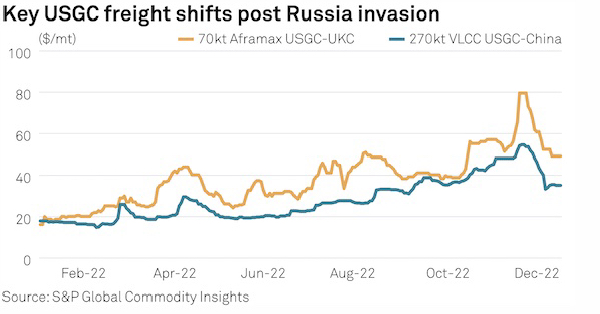The Americas dirty tanker markets will continue to face a bullish yet uncertain 2023 as increased ton-mile demand induced by Russian oil sanctions couples with an ever-shifting crude demand landscape to drive tanker market direction.
Freight for midsize tankers has been on an uptrend since February, as European crude buyers have shifted to sourcing Russian replacement crude barrels from regions requiring longer voyages, most notably resulting in an upswing in tanker movements into Europe out of the US Gulf Coast, West Africa, Brazil, and the Middle East. With the implementation of the Russian crude ban on Dec. 5, minimal impacts have been seen to tanker freight itself, however the market is taking a watch-and-see stance heading into 2023, expecting that these trade flow shifts will only be further exacerbated.
Total dirty tanker ton-mile demand is expected to increase by over 6% in 2023 and by around 5.5% in 2024, midsize dirty tanker owner Teekay Tankers Ltd. said in their third quarter 2022 earnings call on Nov. 3.
“There is no room for this to ease any time soon, especially with the changes on Dec. 5,” a charterer said. “The arbitrage is the only thing keeping freight low, it just doesn’t make sense to move the barrels at the record high freight levels.”
The high freight environment could remain in the short to medium term, with mild volatility spikes possible as trans-Atlantic cargo demand fluctuates. Freight costs will dictate arbitrage volumes headed out of the USGC to Europe versus other regions.
Freight for Aframaxes loading in the USGC not only hit all-time highs in November, but increased from the previous all-time high by just over 24%. The benchmark 70,000 mt USGC-UK Continent run peaked at w425, or $79.56/mt, on Nov. 18-22.
Looking ahead, the Forward Freight Agreement market continues to signal an overall firm market in the year ahead, with the 70,000 mt USGC-UKC route last trading Dec. 7 at $38.50/mt for the calendar year 2023, or a w205.66 equivalent based on a 2022 Worldscale flat rate basket of $18.72/mt. The January 2023 contract traded at a range of $47.70/mt to $53/mt throughout December, or a Wordscale 2022 equivalent of w254.81 to w283.12.
Outside of the impacts of the Russia-Ukraine war on midsize tankers, VLCCs have increasingly been taken on USGC crude export runs to Europe, a dynamic that is expected to continue in the near future. The fixture count for VLCCs making USGC-to-Europe runs in November 2022 clocked in at 13, while only three fixtures were reported in November 2021, marking a 77% increase year on year, according to S&P Global Commodity Insights data. The number of VLCCs making the same run in December 2022 had already reached 13 by Dec. 21, on track to eclipse the November tally and surpass the number of transatlantic-bound Suezmaxes in the same period.
Bearish crude demand factors
A handful of bearish demand factors could square up against the bullish market that led to all-time highs in the second half of 2022.
Global oil demand growth is expected to clock in at a measly 2 million b/d in 2023, with Asian destinations projected to drive crude uptake on the back of expected projected easing of coronavirus-related lockdowns in China, according to analysts at S&P Global. Crude demand surrounding the Atlantic Basin, however, is expected to contract, notably in the US and Europe as economic woes of inflation and recessionary concerns continue to dampen crude needs.
Platts assessed freight for the benchmark VLCC 270,000 mt USGC-China route at lump sum $14.75 million on Nov. 21, a high not reached since April 2020 at the tail end of the floating storage boom, S&P Global data shows.
Orderbook, regulations create tight supply picture
All arrows are pointing upward for dirty tanker supply in 2023, with a lean orderbook, increased scrapping expectations, and environmental regulations kicking in in the new year.
The tanker orderbook is currently at its lowest level since 2001, with 118 newbuilds scheduled for delivery in 2023, just under 47% of the annual average of 252 newbuilds, shipbroker Affinity showed in their report on Dec. 14.
With net fleet growth minimal year on year, as vessels reach the age of 20 and over they will be removed from the commercial trading fleet, further limiting options and aiding in higher spot freight. The age of the global tanker fleet continues to grow, which, at an average of 12.1 years, marks an almost 20-year high, International Seaways said in their third quarter 2022 earnings call on Nov. 8.
Source: Platts









































